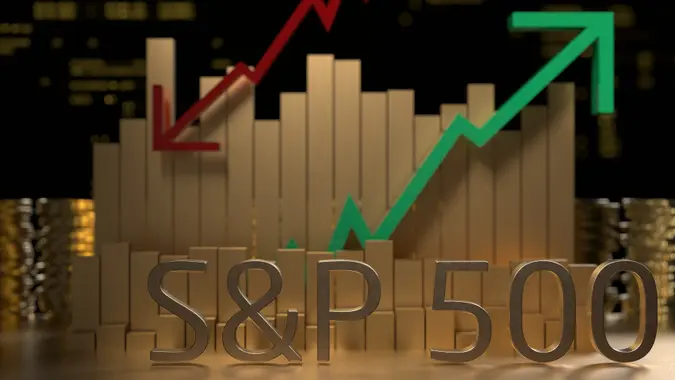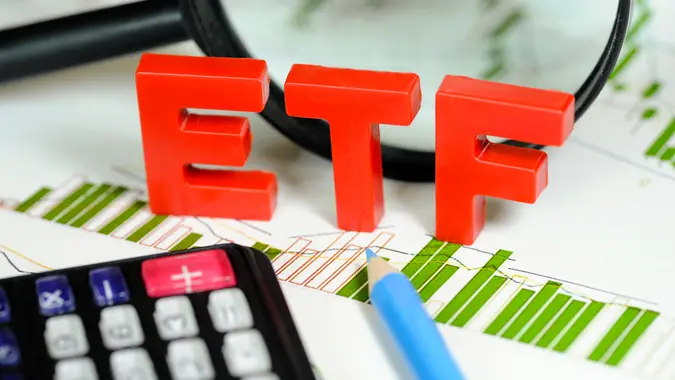What Are Credit Default Swaps?

Commitment to Our Readers
GOBankingRates' editorial team is committed to bringing you unbiased reviews and information. We use data-driven methodologies to evaluate financial products and services - our reviews and ratings are not influenced by advertisers. You can read more about our editorial guidelines and our products and services review methodology.

20 Years
Helping You Live Richer

Reviewed
by Experts

Trusted by
Millions of Readers
Credit default swaps (CDSs) provide protection for investors in the event that the borrower defaults on their debt or loan. They can play a pivotal part in financial and investment industries, as they can be essential for risk management.
CDSs, however, also played a pivotal role in the 2008 financial crisis. In this post, we’ll discuss how credit default swaps work, how they’re used, and the risks and benefits to consider.
What Is a Credit Default Swap?
A credit default swap is afinancial contract that allows an investor to offset their credit risk. It functions like insurance for bondholders or lenders, and is commonly used in bond markets and corporate debt protection.
They’re commonly used by lenders who are worried about borrowers defaulting on their loans or debt.
Many credit default swaps (CDSs) are maintained through ongoing premium payments, similar to conventional insurance that requires regular premiums.
How Does a Credit Default Swap Work?
There are two parties in a CDS contract. The first is the buyer, who is seeking protection. The second is the seller, who is providing protection.
The contract will require regular payments from the buyer to the seller to protect the debt. If the buyer’s borrower defaults on the debt, the seller will compensate the buyer for their loss.
As an example, an investor may use a CDS to protect the corporate bonds they’re holding.
They may have invested in corporate bonds that were sold by the company for a fundraising opportunity. If they’re concerned about not receiving the return on their investment– which may happen if they’re concerned about the company’s potential growth trajectory or current economic conditions– they may use a CDS as a form of protection.
The payout may be triggered by a credit event, including a failure for the borrower to make payments, non-payment related default, a dispute in contract validity, or actions are taken by the government that impact the government.
Risks and Benefits of Credit Default Swaps
There are both risks and benefits that come with using credit default swaps.
Benefits of CDSs
The benefits of CDSs include:
- May help investors hedge against credit risk.
- Provides liquidity in the credit market by facilitating the trade of credit risk, which allows investors to move quickly.
- Allows institutions to diversify risk exposure with portfolio protection.
Risks of CDSs
The risks of CDSs, which should not be overlooked, include:
- Can be highly speculative, which can decrease their efficiency, and increase market volatility.
- Risk of default if the CDS seller can’t pay their end of a CDS if needed; if this occurs, the buyer may face losses.
- Played a major role in the 2008 financial crisis due to misuse and lack of regulation.
How Are Credit Default Swaps Used?
Credit default swaps are most used to protect investments in corporate or government bonds. They involve speculating on the creditworthiness of companies or countries that you’re investing into.
Banks, financial institutions, and investors, therefore, use CDSs for risk management. It adds a significant layer of protection that provides improved liquidity and allows for a hedge against credit risk.
It’s important to note that the Dodd-Frank Act authorized the SEC and the CFTC to regulate over-the-counter swaps market for securities, which is a category that includes CDSs. However, the CDS market has been less regulated than other markets.
When Is a CDS Removed or Expired?
A CDS contract ends when the following occurs:
- The underlying debt matures without default.
- The borrower defaults and the payout is made by the seller.
- The contract term expires, as detailed by the original agreement between the buyer and seller.
It’s important to closely monitor your CDS expiration dates and all relevant credit events.
Monitoring CDS expiration dates is important because:
- A CDS is like insurance that ends on a specific date.
- When it expires, you lose protection against defaults.
- You need to decide whether to renew, replace or accept the risk.
- Expiring protection can leave unexpected gaps in your risk management.
Monitoring credit events is crucial because:
- Credit events trigger payments on CDS contracts.
- These events include bankruptcy, failure to pay or debt restructuring.
- Missing a credit event could mean not getting paid when you should.
- The specific definition of what counts as a credit event matters and is written in the contract.
- There’s often a short window to file claims after a credit event.
- Documentation requirements must be met to receive payment.
The Role of Credit Default Swaps in the Financial Market
CDSs can improve investor liquidity, but may also contribute to market volatility. They don’t directly impact interest rates, but may indirectly influence them by strengthening the market’s perceptions of credit risks.
We learned in the 2008 financial crisis that they can impact economic stability, especially when they’re used without transparency and regulation.
We learned that CDS created significant hidden risks when they weren’t run transparently. Companies like AIG sold insurance against defaults without having enough money to pay if things went wrong. When housing crashed, this triggered a chain reaction where many firms faced collapse at once.
Before 2008, these contracts were traded privately with little oversight. No one — not even regulators — could see the full picture of who owed what to whom. This lack of transparency meant that when trouble hit, no one knew exactly where the risks were or how bad things might get, causing panic throughout the financial system.
The aftermath brought important changes, including:
- Requirements for centralized clearing
- Better visibility into trades
- Regulations ensuring sellers have enough capital to back their promises
These new changes have increased the protection that CDSs offer while reducing the potential risk, though it’s important to note that there are still both risks and benefits to leveraging them.
- What is a credit default swap in simple terms?
- A credit default swap is essentially insurance against a company or government defaulting on its debt, where one party pays regular fees to another party who promises to compensate them if a default occurs.
- How does a CDS differ from traditional insurance?
- Unlike traditional insurance, you don't need to own the debt to buy CDSs. These contracts can be used both as protection for actual lenders and as speculative bets on whether defaults will happen.
- Who buys and sells credit default swaps?
- Buyers of credit default swaps typically include bondholders seeking protection against defaults, portfolio managers hedging credit risk, and speculators betting on credit deterioration. Sellers are usually financial institutions, insurance companies, and hedge funds looking to earn premium income by taking on credit risk, effectively betting that defaults won't occur.
- Why did CDSs contribute to the 2008 financial crisis?
- Credit default swaps made the 2008 crisis worse when large companies sold too many CDSs on bad housing loans without enough funds to pay when the loans failed. Too many loans failed at once, and when the companies couldn’t pay what was promised, there was disruption across the entire banking system.
- Are credit default swaps legal and regulated today?
- Credit default swaps are legal and more regulated now than before 2008. After the financial crisis, new laws required most CDS trades to go through clearing houses and be reported to regulators to make the market safer.
Our in-house research team and on-site financial experts work together to create content that’s accurate, impartial, and up to date. We fact-check every single statistic, quote and fact using trusted primary resources to make sure the information we provide is correct. You can learn more about GOBankingRates’ processes and standards in our editorial policy.
- Cornell Law School "credit default swap"
- KelloggInsight "What Went Wrong at AIG?"
- Commodity Futures Trading Commission "Dodd-Frank Act"
 Written by
Written by  Edited by
Edited by 

























